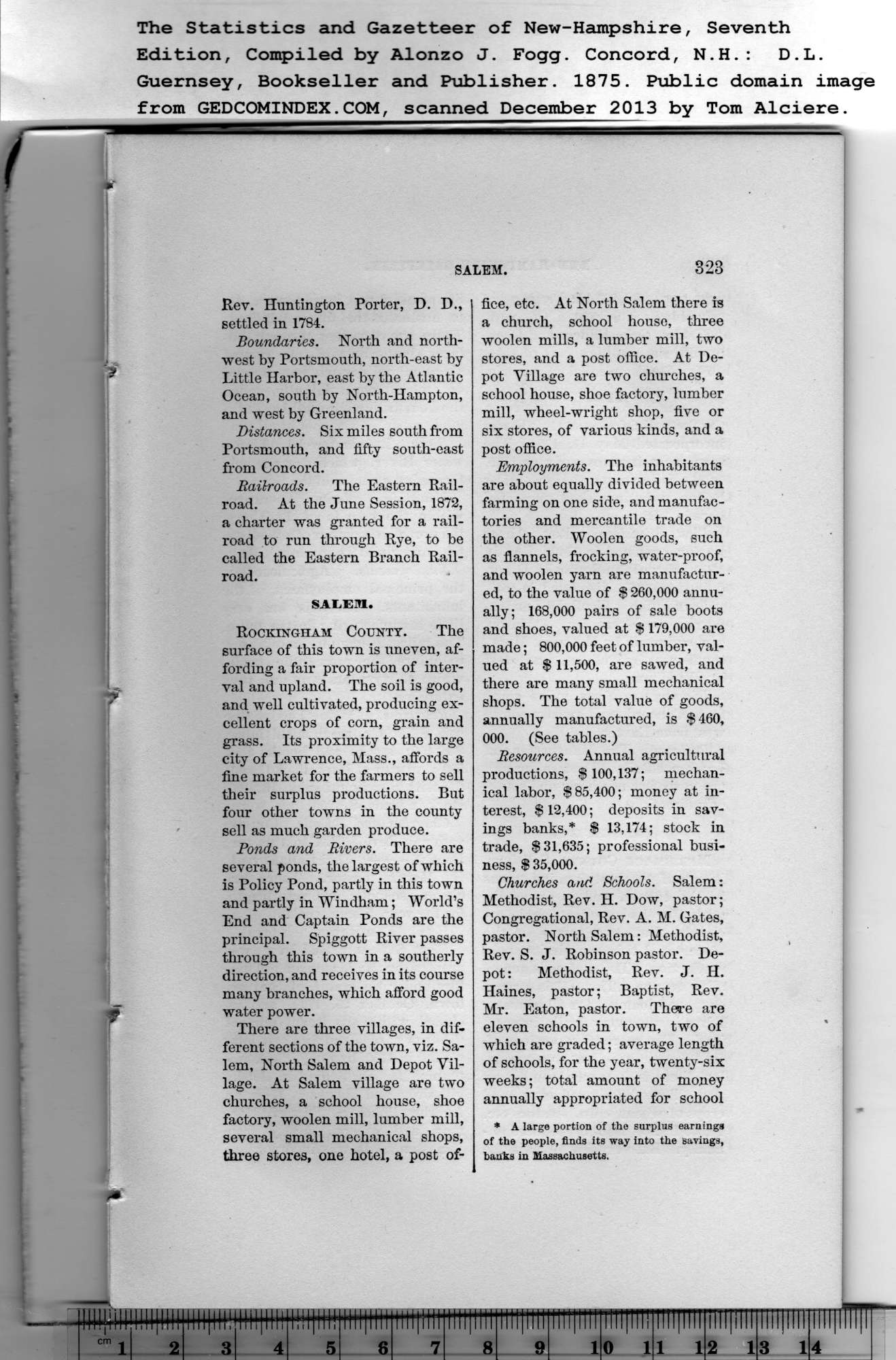|
Rev. Huntington Porter, D. D.,
settled in 1784.
Boundaries. North and north-
west by Portsmouth, north-east by
Little Harbor, east by the Atlantic
Ocean, south by North-Hampton,
and west by Greenland.
Distances. Six miles south from
Portsmouth, and fifty south-east
from Concord.
Railroads. The Eastern Rail-
road. At the June Session, 1872,
a charter was granted for a rail-
road to run through Rye, to be
called the Eastern Branch Rail-
road.
SALEM.
Rockingham County. The
surface of this town is uneven, af-
fording a fair proportion of inter-
val and upland. The soil is good,
and well cultivated, producing ex-
cellent crops of corn, grain and
grass. Its proximity to the large
city of Lawrence, Mass., affords a
fine market for the farmers to sell
their surplus productions. But
four other towns in the county
sell as much garden produce.
Ponds and Rivers. There are
several ponds, the largest of which
is Policy Pond, partly in this town
and partly in Windham; World’s
End and Captain Ponds are the
principal. Spiggott River passes
through this town in a southerly
direction, and receives in its course
many branches, which afford good
water power. |
There are three villages, in dif-
ferent sections of the town, viz. Sa-
lem, North Salem and Depot Vil-
lage. At Salem village are two
churches, a school house, shoe
factory, woolen mill, lumber mill,
several small mechanical shops,
three stores, one hotel, a post of-
fice, etc. At North Salem there is
a church, school house, three
woolen mills, a lumber mill, two
stores, and a post office. At De-
pot Village are two churches, a
school house, shoe factory, lumber
mill, wheel-wright shop, five or
six stores, of various kinds, and a
post office.
llll|lll[l|||iP]llll|Ptill|llll|l!!lllll!|llll|llll|llll||[ll|ltttp
Employments. The inhabitants
are about equally divided between
farming on one side, and manufac-
tories and mercantile trade on
the other. Woolen goods, such
as flannels, frocking, water-proof,
and woolen yarn are manufactur-
ed, to the value of $ 260,000 annu-
ally; 168,000 pairs of sale boots
and shoes, valued at $ 179,000 are
made; 800,000 feet of lumber, val-
ued at $ 11,500, are sawed, and
there are many small mechanical
shops. The total value of goods,
annually manufactured, is $460,
000. (See tables.)
Resources. Annual agricultural
productions, $ 100,137; mechan-
ical labor, $85,400; money at in-
terest, $ 12,400; deposits in sav-
ings banks,* $ 13,174; stock in
trade, $31,635; professional busi-
ness, $ 35,000.
Churches and Schools. Salem:
Methodist, Rev. H. Dow, pastor;
Congregational, Rev. A. M. Cates,
pastor. North Salem: Methodist,
Rev. S. J. Robinson pastor. De-
pot : Methodist, Rev. J. H.
Haines, pastor; Baptist, Rev.
Mr. Eaton, pastor. The*re are
eleven schools in town, two of
which are graded; average length
of schools, for the year, twenty-six
weeks; total amount of money
annually appropriated for school
* A large portion of the surplus earnings
of the people, finds its way into the savings,
banks in Massachusetts. |
